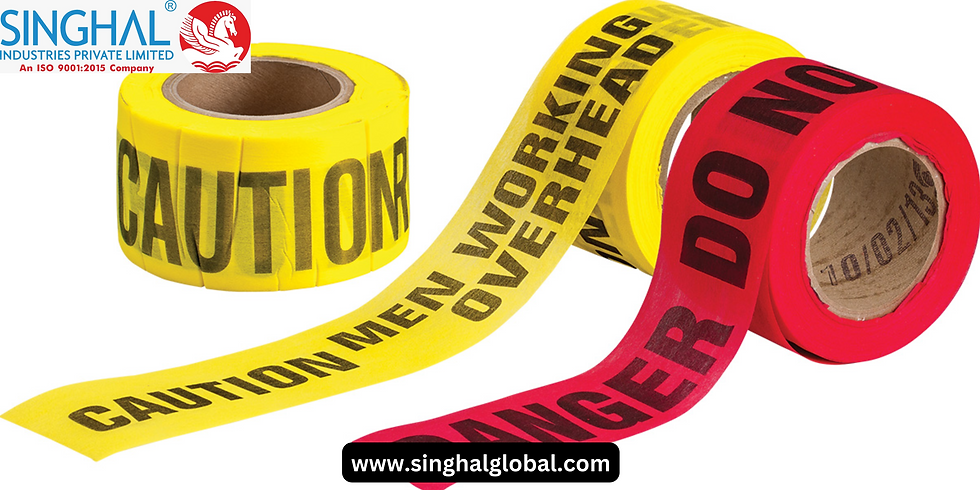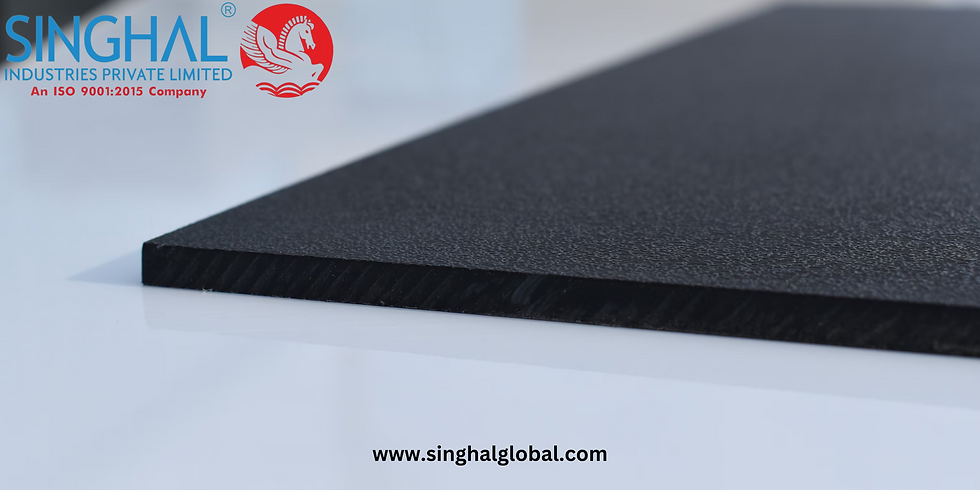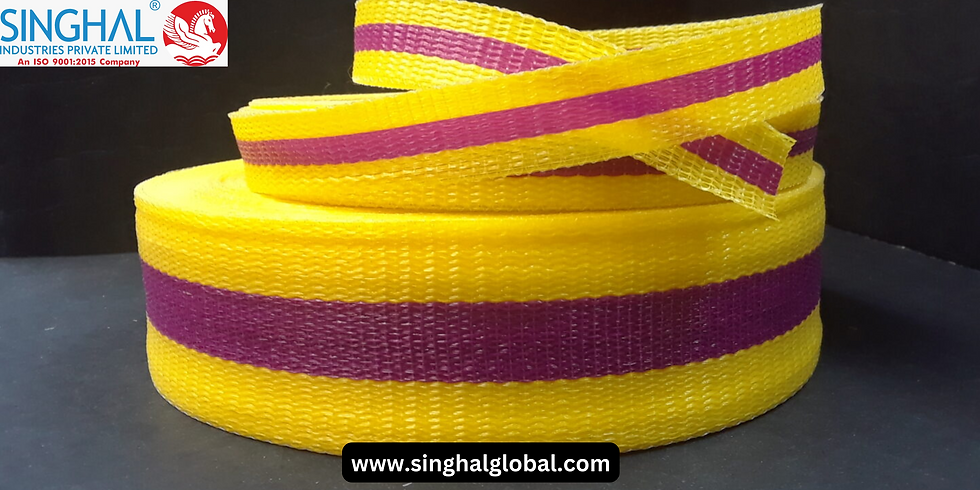How Barricade Tape Helps in Construction, Events, and Emergency Response
- Singhal Industries Private Limited
- Nov 27, 2024
- 9 min read
Barricade tape is an essential tool in a variety of safety and hazard-related contexts. Whether used in construction zones, during crowd control, or in emergency situations, this highly visible tape is designed to clearly demarcate restricted areas, alerting individuals to potential dangers. This guide explores the different types of Barricade tape in India, its key features, and its wide range of applications across industries.
Barricade tape is primarily used to indicate caution or warning. It plays a crucial role in preventing accidents and injuries by warning people to stay away from dangerous areas. In this article, we’ll explore the different varieties of barricade tape, how to choose the right tape for your needs, and why it’s a vital component of workplace safety.
Types of Barricade Tape
Standard Barricade Tape
This is the most common type of barricade tape, often marked with clear cautionary messages like "Caution" or "Do Not Enter." It’s used to prevent access to potentially dangerous areas.
Heavy Duty Barricade Tape
Designed for high-traffic or harsh environments, this type of tape is thicker and more durable, ideal for construction zones or areas that experience extreme weather.
Reflective Barricade Tape
Reflective tape features a reflective coating that makes it visible even in low-light conditions, ensuring maximum safety at night or in dim environments. It’s commonly used on roadsides and construction sites after dark.
Key Features of Barricade Tape
Barricade tape is characterized by its high visibility and durability.
Material Composition
Most barricade tapes are made from polyethylene or vinyl, offering a combination of flexibility and resistance to wear and tear. Some tapes are designed for extra durability, with enhanced UV resistance to withstand long-term exposure to the sun.
Durability and Weather Resistance
Barricade tape is made to last, with resistance to weather conditions such as rain, wind, and extreme temperatures. The tape is generally lightweight yet designed to endure the elements in outdoor environments.
Brightness and Visibility
Barricade tape typically comes in bright colors, such as yellow and red, that make it easy to spot from a distance. The high contrast of these colors makes the tape easily visible in most environments, ensuring safety.
Applications of Barricade Tape
Barricade tape is used in a variety of industries and scenarios, playing a critical role in maintaining safety. Here are some of the most common uses:
Construction and Roadwork
Barricade tape is crucial in the construction industry to mark hazardous zones, such as excavation sites, roadwork areas, or places with temporary barriers. It alerts workers and the public to avoid these potentially dangerous areas.
Crowd Control and Events
For public events, barricade tape helps guide foot traffic and secures restricted areas. It is often used at concerts, festivals, or sports events to create designated pathways and prevent unauthorized access.
Hazardous Area Marking
Whether in industrial plants or emergency situations, barricade tape is used to mark off hazardous areas. It alerts personnel and the public to stay clear of dangerous materials or activities.
Emergency and Safety Signage
During emergencies such as fires, natural disasters, or accidents, barricade tape is used to establish a perimeter and keep bystanders away from dangerous situations, allowing emergency responders to work effectively.
Why Barricade Tape is Crucial for Safety
Barricade tape serves as a visible and effective means of preventing accidents. It helps manage risk by marking off dangerous areas and providing clear signals to people to stay away. Legal and regulatory guidelines often require its use in workplaces where safety hazards exist, making it an essential part of compliance with safety standards.
Barricade Tape Roll: How to Choose the Right One
When selecting barricade tape for a project or event, it’s essential to consider a few key factors:
Length and Width Considerations
Barricade tapes come in various lengths, typically ranging from 50 to 100 meters, depending on the size of the area to be cordoned off. The width of the tape usually varies from 2 to 5 inches, with wider tapes offering better visibility.
Color and Messaging Options
Barricade tape is available in various colors, including red, yellow, and orange. The messages printed on the tape also vary, with options like "Caution," "Danger," and "Do Not Enter" to suit different needs.
Thickness and Strength
For high-risk areas, thicker and more durable tape is necessary. Heavy-duty rolls are designed for use in construction zones and areas exposed to harsh conditions, providing better performance over extended periods.
Benefits of Using Barricade Tape
Cost-effective Safety Solution
Barricade tape is affordable, making it an economical option for any business or event looking to enhance safety protocols.
Versatility and Ease of Use
Its lightweight and flexible nature allow barricade tape to be easily applied and removed, offering high versatility across industries. It can be stored and transported without hassle.
High Visibility and Clear Communication
The bold colors and reflective properties of barricade tape ensure it is visible in both daylight and low-light conditions, providing clear communication and reducing accidents.
Barricade Tape in Different Industries
Construction
In construction, barricade tape is used to mark off areas where excavation, demolition, or other hazardous activities are taking place, ensuring worker safety and preventing public access.
Event Management
For public events, barricade tape helps maintain order by directing crowds and keeping them away from unsafe zones, like backstage areas or restricted zones.
Emergency Response
During emergencies, barricade tape marks dangerous zones such as fire hazards, accident sites, or chemical spills, preventing public entry and allowing responders to manage the situation.
Common Mistakes to Avoid When Using Barricade Tape
Incorrect Placement
Ensure the tape is placed in areas that need to be clearly marked off. Failing to place it in the correct spots can lead to confusion and accidents.
Ignoring Environmental Conditions
In outdoor environments, it’s important to use weather-resistant tapes that won’t degrade quickly due to rain or sunlight exposure.
Not Adhering to Safety Protocols
Always adhere to local regulations and standards for Caution tape manufacturer in Gujarat usage, as it is crucial for legal and safety reasons.
How Barricade Tape is Made
Barricade tape is made through a process that involves the extrusion of polyethylene or vinyl materials, which are then printed with cautionary messages. The tapes are designed to be durable and weather-resistant, ensuring they can withstand the elements.

Barricade Tape Manufacturers and Exporters
When purchasing barricade tape, it’s essential to source from reputable manufacturers or exporters who provide quality products. Look for certifications and industry standards that guarantee reliability and performance.
Cost Factors for Barricade Tape
The cost of barricade tape can vary depending on several factors, such as the material, thickness, length, and whether it's reflective. Here’s a breakdown of the major cost factors to consider:
Material and Type
The material of the tape plays a significant role in determining its price. Polyethylene tapes are usually more affordable, while heavy-duty or reflective tapes tend to be more expensive due to their specialized manufacturing processes and added features.
Bulk Orders vs. Individual Purchases
Buying barricade tape in bulk typically results in a lower cost per roll. Many industries prefer bulk purchases because they can store large quantities for long-term use, ensuring cost-effectiveness. For smaller projects or one-time use, buying individual rolls is more practical, but the cost per roll will be higher.
Special Features
Tapes with specific features, such as UV protection, superior durability, and reflective coatings, can be more expensive than basic caution tape. The investment in higher-quality tape is often justified in high-risk environments, where durability and clear visibility are essential.
Barricade Tape and Environmental Impact
Barricade tape, like many disposable products, can have an environmental impact. Here are some important points about its sustainability:
Recyclability
Most types of barricade tape are made from polyethylene, which is recyclable. This means that once the tape has outlived its purpose, it can be collected, processed, and turned into new products. However, the rate of recycling depends on the local recycling infrastructure and whether the tape is properly disposed of after use.
Efforts to Reduce Environmental Footprint
Some manufacturers are now producing eco-friendly versions of barricade tape, made from biodegradable materials or with lower environmental impact during production. If sustainability is a priority, look for these environmentally conscious alternatives.
Reducing Plastic Use
In light of growing concerns over plastic waste, some businesses are exploring alternatives to plastic-based barricade tapes, such as those made from natural fibers or other biodegradable substances. These alternatives provide a more sustainable option, though they might not yet offer the same durability as traditional polyethylene tape.
Barricade Tape in India and Its Market Growth
As the demand for safety and cautionary materials grows worldwide, India is experiencing an increase in the use of barricade tape across several industries. Key industries contributing to the growth include construction, event management, and public safety. Here are some factors driving the growth:
Infrastructure Development
India’s rapid urbanization and infrastructure development have led to increased use of barricade tape in construction and roadwork. The safety standards in these sectors require effective perimeter marking to prevent accidents, leading to a rising demand for barricade tape.
Event Management Industry
India hosts numerous events, from large-scale festivals to international conferences. Barricade tape is indispensable in these settings for crowd control and to ensure the safety of participants and attendees. As the events industry continues to grow, so does the need for high-quality barricade tape.
Regulations and Safety Awareness
With increased awareness about safety, industries in India are adopting better safety protocols, including the use of barricade tape for marking hazardous areas. This growing emphasis on safety compliance is pushing the demand for quality barricade tape.
Expert Insights on Barricade Tape Usage
Experts in safety and construction management emphasize the importance of using high-quality barricade tape to prevent accidents. Here are some key insights:
Versatility and Importance
According to safety experts, barricade tape is considered a versatile tool because it can be easily applied and removed, providing a cost-effective solution to hazard marking. For areas where permanent barricades are not necessary, barricade tape is an ideal choice to ensure temporary safety.
Choosing the Right Tape
Industry professionals recommend considering the environment and specific needs when selecting barricade tape. For high-traffic construction sites, heavy-duty or reflective tape may be necessary to ensure maximum visibility. For events, basic caution tape may be sufficient to guide foot traffic safely.
Legal Compliance
Safety managers emphasize that in certain jurisdictions, the use of barricade tape is a regulatory requirement. Adhering to these regulations not only helps avoid legal repercussions but also ensures the safety of workers, the public, and event participants.
Future Trends in Barricade Tape
As industries continue to evolve, barricade tape is also undergoing innovations. Here are a few future trends:
Technological Advancements
Smart barricade tapes that integrate with IoT (Internet of Things) technology could provide real-time updates on the status of marked zones, enhancing workplace safety. These advanced tapes could alert authorities if a tape is disturbed or moved, helping prevent unauthorized access to hazardous zones.
Sustainability Trends
As more industries become aware of their environmental impact, there is a growing interest in developing biodegradable or recyclable barricade tapes. The future could see a wider range of sustainable options available on the market, which would reduce the overall environmental footprint of the product.
Customizability
With advancements in printing technologies, barricade tape is becoming more customizable. Companies may opt for tapes that feature their own branding, safety messages, or color schemes. Customization allows businesses to communicate more specific warnings and create a more professional appearance on job sites.
How to Properly Store and Maintain Barricade Tape
To ensure the longevity of barricade tape, proper storage and maintenance are essential:
Storage Recommendations for Longevity
Barricade tape should be stored in a cool, dry place away from direct sunlight and extreme temperatures. Exposure to harsh environmental conditions can cause the tape to lose its color and deteriorate over time. Keeping it in a sealed container or wrapped up can also prevent dirt and dust from accumulating on the tape, ensuring it remains in good condition for future use.
Avoiding Overstretching
When using barricade tape, avoid overstretching the material, as this can weaken the tape and reduce its visibility. If the tape becomes stretched or torn, it should be replaced immediately to ensure continued safety.
Barricade Tape: Legal and Regulatory Aspects
Barricade tape usage is often governed by safety regulations, particularly in construction and public safety scenarios. It's important to be aware of the legal requirements for using barricade tape, as failing to follow safety guidelines can result in fines or accidents.
Regulations in Construction
Construction sites are often required to clearly demarcate dangerous zones with barricade tape or similar materials. This helps ensure the safety of workers and the public. In many countries, including India, regulations mandate the use of high-visibility caution tape in hazardous areas to comply with worker safety laws.
Public Events and Safety Compliance
Event organizers are also expected to adhere to safety protocols, including the proper use of Barricade tape roll. Regulatory bodies may require the installation of tape to prevent unauthorized access and avoid overcrowding in specific areas. Non-compliance can result in penalties or jeopardize the event’s safety status.
Conclusion
Barricade tape plays a vital role in maintaining safety across multiple industries, from construction to emergency response. Its bright colors, durability, and ease of use make it an essential tool for marking hazardous areas, guiding traffic, and ensuring compliance with safety standards. As industries continue to focus on safety and sustainability, barricade tape is likely to evolve, offering even more versatile and eco-friendly options in the future.
Frequently Asked Questions (FAQs)
What colors of barricade tape are available and what do they mean?
Barricade tape typically comes in bright colors like yellow, red, and orange. Yellow generally indicates caution, red signifies danger, and orange is used to indicate restricted access or caution around construction areas.
How long does barricade tape last?
The lifespan of barricade tape depends on the material and environmental conditions. Generally, high-quality polyethylene tape can last for months when stored properly, but it may degrade more quickly if exposed to extreme weather conditions.
Can barricade tape be reused?
Barricade tape is generally designed for single-use in many cases, especially if it becomes dirty, stretched, or damaged. However, if the tape remains intact and clean, it can be reused for less demanding applications.



Great insights! Barricade tape plays a crucial role in ensuring safety across construction sites and events. The way you connected WPC materials to its durability and effectiveness is truly informative.